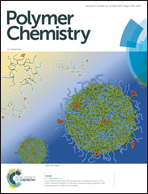Reinvestigation of the mechanism of polymerization of β-butyrolactone from 1,5,7-triazabicyclo[4.4.0]dec-5-ene†
Abstract
The questionable mechanism initially proposed to explain how 1,5,7-triazabicyclo[4.4.0]dec-5-ene (TBD) allows us to ring-open β-lactones, such as β-butyrolactone (BL), is reinvestigated here. With the use of a trisubstituted β-lactone, i.e. (R,S)-benzylcarbonyl-3,3-dimethyl-2-oxetanone, and the association of techniques such as 1H/DOSY NMR and MALDI/ESI-MS, we demonstrated that BL is effectively polymerized by the TBD in bulk at 60 °C, minorly from the reported N-acyl-α,β-unsaturated TBD species, and majorly from crotonate anions issued from the basic activation of BL. In contrast to what has been reported, the TBD is not covalently linked to the PBL chain but mainly plays the role of a counterion in the –C(O)O−, TBDH+ active site.
![Graphical abstract: Reinvestigation of the mechanism of polymerization of β-butyrolactone from 1,5,7-triazabicyclo[4.4.0]dec-5-ene](/en/Image/Get?imageInfo.ImageType=GA&imageInfo.ImageIdentifier.ManuscriptID=C8PY00206A&imageInfo.ImageIdentifier.Year=2018)


 Please wait while we load your content...
Please wait while we load your content...